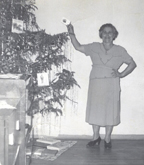first snow
December 8, 2013
o come, thou key of david, come2nd entry – christmas 2013
10th entry – 8th grade

| Old Calabrese | Modern Italian | Dates and Feast-days |
| u quàttru Barbara | il quattro Barbara | December 4 – St. Barbara |
| u sie Nicola | il sei Nicola | December 6 – St. Nicholas |
| u òttu Maria | l’otto Maria | December 8 – Immaculate Conception |
| u tridici Lucia | il tredici Lucia | December 13 – St. Lucy |
| e lu vinticinque lu Missìa | e il venticinque il Messia | December 2 – Birth of the Messiah |
 When we first got to Sault Ste Marie, my grandmother whose her image is on the left, taught me this rhyme and I remember thinking it was a fun way of marking off the days until Christmas. But as the years went by, I forgot the last part and could only remembered the first couple of lines. I’ve been trying to find the rhyme online, but have had no success. Finally, I took a chance and wrote it phonetically, in Old Calabrese, into the Google search-box and found it posted by Francesco Pecora on his Facebook page. Francesco lives in Polistena a small town in south eastern Calabria.
When we first got to Sault Ste Marie, my grandmother whose her image is on the left, taught me this rhyme and I remember thinking it was a fun way of marking off the days until Christmas. But as the years went by, I forgot the last part and could only remembered the first couple of lines. I’ve been trying to find the rhyme online, but have had no success. Finally, I took a chance and wrote it phonetically, in Old Calabrese, into the Google search-box and found it posted by Francesco Pecora on his Facebook page. Francesco lives in Polistena a small town in south eastern Calabria.
Below is his text:
Il detto descrive il modo con cui i nostri antenati annunciavano le feste nel periodo dell’Avvento; Il 30 Novembre, infatti, si festeggia S. Andrea Apostolo, che introduce le festività di: Santa Barbara (4 Dicembre), San Nicola (6 Dicembre), l’Immacolata (8 Dicembre), Santa Lucia (13 Dicembre) e il Santo Natale (25 Dicembre).
By the time we moved from my grandparents’ house to our own, the rhyme remained only in my head. In 1960’s Canada, the only feast-day celebrated before Christmas was the Immaculate Conception. At St. Veronica’s, Sister Drusilla insisted on using only the Advent cycle to mark off the days until December 25. And the rhyme lost its purpose when TV began running the Jingle Bells cartoon counting down the shopping days till Christmas. Who cared about Santa Barbara and Santa Lucia when there were gifts to be had.